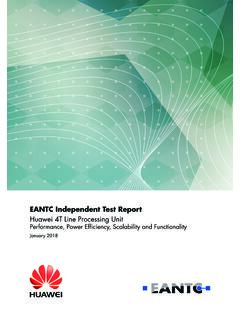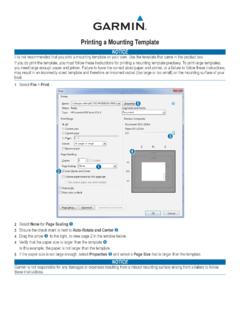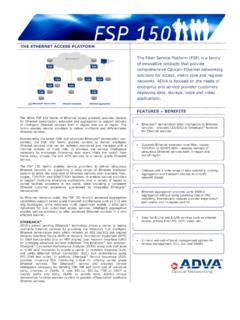Transcription of Flow A Flow B - eantc.de
1 Introduction Executive Summary adva Optical Networking commissioned EANTC to adva FSP 150 ConnectGuard Ethernet data verify the functionality of its FSP 150 customer protection, based on the Media Access Control (MAC). premises devices. EANTC conducted a range of tests Security standard defined in IEEE and of the encryption functions, with a particular focus on IEEE , uses a hardware-based Carrier Ethernet data protection use cases. The tests design for encryption of Carrier Ethernet services with were carried out at EANTC's lab in Berlin, Germany, Gigabit Ethernet and 10 Gigabit Ethernet line speed, in July 2018. Our tests corroborated the functional allowing the transport of sensitive data across wide aspects of the encryption device along with specific area networks and supporting point-to-point topology. key performance indicators related to the security of EANTC conducted a vendor-defined limited set of transmitted data. functionality tests of the encryption features.
2 These tests Frequently, service providers are challenged to meet were successful and the results met our expectations. enterprise demands for network service security. Throughput and latency tests were based on Gigabit Customers want to host data or applications in Ethernet hardware showing promising results. adva . centralized data centers but are reluctant to transport claimed that the device's price point can turn data link sensitive data across public or third-party networks, encryption into a standard product for Service which are considered to be untrustworthy Provider markets. environments. adva FSP 150 edge devices implement We found that the adva FSP 150 is suitable as an the highly secure AES-256 encryption algorithm edge device for securing multiple flows between applied for Ethernet or IP services, protecting user data branch, headquarter and data-center premises. This is as well as control and management traffic. enabled not only by encryption usage but also by detecting issues in Carrier Ethernet networks and Test Highlights offering hardware tamper resistance.
3 MACSEC hardware encryption adds only s latency to a P2P link Hardware: adva FSP 150. Automatic start/stop of traffic flows and key exchanges triggered by IEEE CFM. alarms No frame loss in 1-minute Diffie-Hellman key exchange interval scenario for 7 concurrent sessions Tamper-proof hardware protecting passwords Hardware Software Version and keys Type (used for automatic start/. Encryption is known to affect performance indicators FSP 150- stop of key exchange test case). such as latency and throughput. The adva FSP 150 GE114 Pro (C). (used for all other tests). implements encryption in hardware to meet customer requests for high performance and low latency. The Crypto "C" variant of the FSP 150 series is an L2/. According to adva the FSP 150 devices complement L3 encryption device for the secure connection of main encryption with tamper-resistant design and a trusted and branch offices via Carrier Ethernet services. Two compute platform for secure storage of keys and for devices with hardware version were used and software attestation.
4 Security control is only as secure tests were performed with traffic generators creating as the applied key exchange and key storage flows with Ethernet traffic mix ( EMIX ) consisting of a mechanisms. range of frame sizes to ensure a realistic Ethernet traffic load in a Carrier Ethernet service. EANTC Test Report: adva ConnectGuardTM Ethernet Page 2 of 9. Hardware Overview Secure EVPL. The FSP 150 version under test comes with special Media Access Control Security (MACsec) enables the HW engine for encryption related functions. The HW encryption of data between two sites connected via an engine ensures the performance and precision of untrusted network. In this test case, we considered two business-critical security tasks. scenarios, each with two traffic flows transported via a One of the key functions is a Random Number Carrier Ethernet EVPL. Refer Table 1. Generator which generates a physical random bit stream and random numbers at high speeds. The Flow A Flow B.
5 Security of cryptographic exchange depends on the Scenario 1 Sensitive data Non-sensitive data quality of the random numbers used. Good random numbers are fundamental to almost all secure Scenario 2 Sensitive data Sensitive data computer systems; in case they would lack quality and could be predicted by an attacker, encrypted Table 1: Secure EVPL - Test Scenarios information would be compromised. In other words, the random number generator is a critical component For the first scenario, adva mapped flow A to one for the security of the system. EVC encrypted as a single Secure Flow; Flow B was mapped to a different EVC and transmitted in clear adva explained that the additional HW components text. This is shown in Figure 1. In the second scenario, dual-port, dual-media QSGMII/SGMII GbE PHY both flows were secured. enables network-wide layer 2 MACsec encryption and preserves nanosecond-level IEEE 1588v2 network The goal of this test was to confirm that the content in timing accuracy due to its Intellisec and VeriTime the frames, corresponding to a secure EVC, was features.
6 In summary, the ASIC enables handling of encrypted. This includes everything except the MACsec encryption in combination with single/dual transport VLAN tag. In the same manner, the content VLAN tag bypass as well as frequency, phase and of the frames corresponding to the unsecured EVC was time distribution for secure end-to-end services. in clear text. We generated traffic consisting of different frame sizes ( Ethernet MIX ). Other parameters are specified in Table 2. Test Results: Functionality We monitored traffic flows between the two FSP 150. Following FSP 150 features were tested: units. EANTC concluded that the FSP 150 was able to separate traffic flows and perform encryption correctly Secure EVPL following the configuration, as was expected. Required VLAN tags in the clear for bypass SECTAG format compliance Password authenticated Diffie-Hellman Key Exchange Tamper resistance Crypto user permissions Automatic Start/Stop of Key Exchange Messages Secure Flow Plaintext Flow VLAN Tag in the Clear Figure 1: Secure EVPL.
7 EANTC Test Report: adva ConnectGuardTM Ethernet Page 3 of 9. Tag added by the Traffic Generator (TFGEN) was Parameter Value encrypted. Bandwidth per direction 100 Mbit/s We witnessed three successful test case executions, each with a 200 Mbps traffic flow. The corresponding Key exchange interval flow A 1 minute number of required VLANS in the clear was observed, Key exchange interval flow B 3 minutes allowing the encrypted data to be transported across a single or double VLAN-tagged network as regular Table 2: Parameters for Both Traffic Flows non-MACSec frames. SECTAG Frame Format Compliance VLAN Tags TFGEN. MACsec is defined in IEEE and IEEE S-TAG C-TAG. in the Clear TAG. Complying with this standard is important for interoperability with other vendors. 0 NO TAG NO TAG 32. While we did not perform multi-vendor interoperability 1 NO TAG 3 32. tests, we did inspect frames to confirm that the format of the SECTAG is compliant. This added header 2 1003 3 32. conveys parameters that identify the protocol, key to validate the received frame and provide replay Table 4: VLAN Tag Specification protection.
8 The fields expected to be seen are listed in Table 3. All required fields were present, except the SCI since it is not encoded in SECTAG for point-to-point traffic. Compliance was confirmed as shown in Figure 2. Field Size Figure 3: VLAN Tags in the Clear Ethertype (0x88E5) 2 bytes Diffie-Hellman Key Exchange Tag Control Information (TCI) 4 bits To maintain the security of sensitive data, the keys used to encrypt must be changed frequently. The FSP. Association Number (AN) 4 bits 150 uses the Diffie-Hellman algorithm to perform the key exchange via an unsecured channel between two Short Length (SL) 1 byte encryption devices. Key sizes vary according to Packet Number (PN) 4 bytes groups specified in RFC3526. The adva FSP 150. supports key sizes of 2048 and 4096 bits. Secure Channel Identifier (SCI) - Optional 8 bytes Table 3: SECTag Fields Frame Type Ethertype Value Regular MACSec 0x88E5. Key exchange 0x88B7. Table 5: Ethertype Values Key exchange frames are distinguished from regular MACsec frames by their Ethertype values, displayed in Table 5.
9 In this test, we observed two different Secure Flows to determine whether the key exchange would Figure 2: SECTAG Section of Captured Frame occur at the configured frequency (the configurable range is 1 60 minutes). Key exchange frames are VLAN Tags in the Clear identified as belonging to a Secure Flow by their The FSP 150 provides support of end-to-end services VLAN tags as seen in Figure 5. while keeping the IEEE protocol format The devices were also configured to use a unicast across the wide-area network. The number of VLAN address belonging to the peer for the key exchange tags in the clear is configurable on each Secure Flow messages. We noticed that the initial frame was independently. Possible values are 0, 1 or 2. We directed to a multicast MAC address and subsequent validated each possible value. Table 4 describes the ones used the unicast MAC address as expected. VLANS used in each scenario, in all of them the VLAN Other parameters are specified in Table 6.
10 EANTC Test Report: adva ConnectGuardTM Ethernet Page 4 of 9. Figure 4: Diffie-Hellman Key Exchange Traffic Separation Both flows showed key exchanges at the desired If the cover of adva FSP 150 is opened during interval; the process did not interrupt normal traffic operation, a tamper event will be reported, the (no frame loss). This feature was tested again passwords will immediately be erased and the performance-wise in a subsequent section. equipment will perform a cold reboot clearing all keys in memory. We tested this function with traffic. The Parameter Value encryption device was configured to run a Secure Flow with no traffic loss. Number of secure flows 2. The cover was opened and the device performed a Flow bandwidth 1 Mbps/flow cold reboot, a new login is seen in Figure 4. A login to Key exchange interval 1 minute the device confirmed that it had effectively erased authentication passwords/keys and showed logs stat- Key size 4096 bits ing ConnectGuard RAM cleared/Key Exchange Authentication Password Missing.













